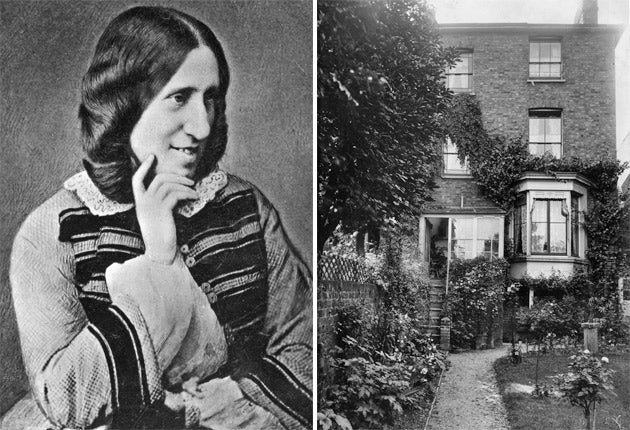Battle to save George Eliot's unspoilt vista
Victorian novelist's home, which inspired 'Mill on the Floss', is at risk from development

Your support helps us to tell the story
From reproductive rights to climate change to Big Tech, The Independent is on the ground when the story is developing. Whether it's investigating the financials of Elon Musk's pro-Trump PAC or producing our latest documentary, 'The A Word', which shines a light on the American women fighting for reproductive rights, we know how important it is to parse out the facts from the messaging.
At such a critical moment in US history, we need reporters on the ground. Your donation allows us to keep sending journalists to speak to both sides of the story.
The Independent is trusted by Americans across the entire political spectrum. And unlike many other quality news outlets, we choose not to lock Americans out of our reporting and analysis with paywalls. We believe quality journalism should be available to everyone, paid for by those who can afford it.
Your support makes all the difference.The wide horizons, leafy views and idyllic isolation of George Eliot's former Wandsworth home were the backdrop to the 19th-century author's great semi-autobiographical work The Mill on the Floss. But that might not be enough to save the building's pristine views from the development pressures of the modern world.
Despite the work of increasingly vocal local campaigners, the views from Eliot's former abode are threatened by a south London developer's plans to build a five-storey block of flats opposite Grade II-listed Holly Lodge, where Eliot lived. The proposals, for 22 dwellings, would destroy previously unspoilt views across a section of south London known for its uninterrupted vistas.
A Wandsworth Council spokesperson confirmed there was permission in place to build on the site of a garage opposite Holly Lodge, saying: "It remains to be seen whether or not this permission will be implemented before it expires."
Eliot wrote The Mill on the Floss at Holly Lodge in 1859. She lived there with her common-law husband, George Henry Lewes, to whom she dedicated the book. From its first page, the classic work describes the "wide plains," along with "green banks" and a "loving tide". The story is about Tom and Maggie Tulliver, a brother and sister growing up near the river Floss near the fictional village of St Ogg's in the early 19th century.
According to the house's custodian and owner, Sarah Roberts, the author would have had undisturbed views that couldn't help but influence the author's writing style during her time living there. "It's no coincidence that she chose to live here and found the inspiration that she did," she said.
Holly Lodge was the first building in south London to receive an English Heritage blue plaque, honouring Eliot, and the first to be dedicated to a woman.
The novelist, whose real name was Mary Anne Evans, once entertained Charles Dickens at Holly Lodge, and wrote of her love of the house in published correspondence.
The listed property sits in the West Hill conservation area of Wandsworth, home to a slew of period properties. None of the homes is taller than three storeys high, with builders obliged to pay attention to the "character" of the area. Views can be enjoyed from every stair and room in Eliot's former home, including the conservatory.
"Our home is very comfortable, with far more of vulgar indulgences in it than I ever expected to have again," writes Eliot of the Lodge in a letter in 1859. "But you must not imagine it a snug place, just peeping above the holly bushes. Imagine it rather as a tall cake, with a low garnish of holly and laurel. As it is, we are very well off, with glorious breezy walks, and wide horizons, well-ventilated rooms, and abundant water."
A number of high-profile houses with links to authors are currently under threat. In July, the authors Julian Barnes, Ian Rankin and Stephen Fry backed a campaign to overturn planning permission to carve up for new development the former home of Sir Arthur Conan Doyle in Hindhead, Surrey. Earlier this month Salman Rushdie and Martin Amis added their weight to a campaign to save the DH Lawrence heritage centre at Durban House, Eastwood.
"There is still, amazingly, an incredible uninterrupted horizon view, east to west from Clapham's ridge to Wimbledon Hill and north to south from West Hill and Wimbledon Hill to Crystal Palace and the North Downs," added Sarah Roberts. "No high rise buildings break the skyline other than Crystal Palace radio tower.
"This is Eliot's view and we want to keep it that way."
A local petition has now amassed more than 120 signatures on behalf of 430 residents in the last week that complain against the development plans. The campaign has also written to seek the support ofthe Prince of Wales, who declined to added his support.
The developer, Michael Austin, was unavailable for comment.
An application for an extension to the original scheme was rejected by Wandsworth Council in September on the grounds that it did not provide sufficient levels of affordable housing.
Join our commenting forum
Join thought-provoking conversations, follow other Independent readers and see their replies
Comments